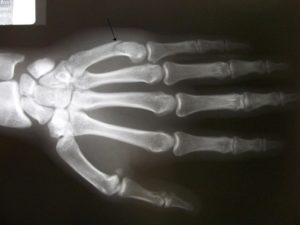Over recent years, boxing has surged in popularity, reaching unprecedented heights in 2024. Current statistics have revealed that within the past year over 1 in 25 adults in the UK plan to participate in boxing, a testament to its appeal.
With this in mind, it’s important to recognise that with this sport comes the risk of injuries; particularly in the hands, as these are your main tools as a boxer. In boxing, only punches delivered by the glove can score points, determining the outcome of a match. This makes the glove not just a symbol of the sport itself, but a critical equipment for safety and injury prevention.
In this blog, we’ll explore the most common hand injuries in boxing, symptoms, treatment and what you can do to prevent these injuries in the first place.
Boxer’s Knuckle
Boxer’s knuckle as the name implies is an injury common amongst the sport. The injury itself refers to the displacement of the extensor tendon hood of the metacarpal-phalangeal joint; known as the knuckle.
When your fist is clenched, and force is applied to the knuckles, the thin tissue that surrounds the tendon becomes vulnerable to damage. This risk increases if the impact of your punch is off-centre, as the pressure from the closed fist can cause one of the sagittal bands holding the extensor tendon to tear. When this happens, the extensor tendon is likely to slip out of position away from the knuckle and settle between the joints, limiting finger movement.
Symptoms
If you ever experience boxer’s knuckle, you are likely to notice pain and swelling around the affected knuckle. If the sagittal band is torn and the extensor tendon snaps, you may also find it difficult to extend or straighten your fingers.
Diagnosing this injury will require a thorough examination to identify the injured structures and to what extent the extensor tendon is damaged. X-rays are commonly used to rule out any associated joint abnormalities which will provide your doctor with a clearer understanding of the extent of the injury.
Treatment
The treatment for boxer’s knuckle depends on the severity of your injury. For those whose extensor tendon remains intact, immobilising the hand with a splint is all that’s needed for a quick recovery.
However, for more severe cases, such as a dislocated tendon, surgery is usually needed to correct the problem. Recovery from surgery can take around 5 months, and your surgeon will likely advise you to avoid returning to the boxing ring until full movement and strength are restored.
Boxer’s Fracture
Another common hand injury in boxing is a boxer’s fracture, accounting for around ¼ of all broken metacarpals, this injury can happen when you deliver a miscalculated high-impact punch with a closed fist.
But what exactly does this injury involve? As the name implies, this injury is a fracture of the fifth metacarpal or the bone that connects the pinkie finger to the wrist. More specifically, the fracture will happen at the neck of the metacarpal, near the joint where it meets the finger bones.
Boxer’s fractures can be classified as either open or closed. If you have an open fracture, the bone will break through the skin, taking longer to heal because of the risk of infections and other complications. Whilst closed fractures are still serious, the bone doesn’t push through the skin, reducing the risk of complications and healing time.
Symptoms
Most people who sustain a boxer’s fracture will feel pain, bruising and swelling concentrated in their hands. You might also notice your finger looking crooked or deformed, particularly the pinkie finger crossing over or behind the ring finger, making it difficult to straighten out; this is known as a rotational deformity.
Treatment
To confirm a boxing fracture, a doctor will likely take an X-ray. The X-ray will allow them to assess the exact location and severity of the break to judge your treatment options.
If your fracture is mild and the broken bone doesn’t move far out of place, then you might only need a splint or cast to heal the bone back into place. If this is the case, it should take 3 to 6 weeks to fully mend.
More severe boxer’s fractures may require a closed reduction to realign your bones. In this instance, your doctor will push the outside of your hand to align with your broken bones. After which, your hand will be placed in a splint or cast until healed.
Whilst most people will avoid surgery for a boxer’s fracture, your doctor may suggest surgery if you have any of the following:
- An open fracture
- A displaced fracture
- A comminuted fracture
Surgery is also an option if the injury damages tissue other than just the fractured bone. During this procedure, your surgeon will perform an internal fixation, which means your surgeon will insert metal pins, screws or a plate into your bone to hold it into place. This may be followed up by a procedure to remove the fasteners after your bone is fully healed.
How can you protect your hands whilst boxing?
As we have previously mentioned, your hands are your biggest asset when it comes to boxing. Therefore, protecting them from injuries requires the correct equipment and technique.
Hand Wraps
Wearing hand wraps is the first and most important step that you can take to protect your hands when boxing. Typically, these elastic bands are there to protect all five fingers and knuckles, securing them tightly to form one protective unit.
Boxing Gloves
Whilst it may seem obvious boxing gloves are there to protect your hands from serious injury, misusing your gloves or wearing ones that aren’t suitable for you will result in a higher chance of injury. If you are a beginner to boxing, it is recommended that you start with a well-padded pair of gloves, this can give you peace of mind whilst you improve your technique.
Technique
Speaking of technique, executing your punches without any technique exposes you to a lot more injuries. From making a proper fist to having the correct rotation of your hand when you deliver a punch, having the right technique is the difference between winning a boxing match and having to spend weeks to months in recovery.
Get in touch today with Ladan Hajipour for expert advice and treatment on all hand and wrist conditions.




